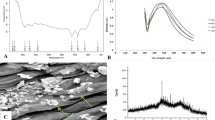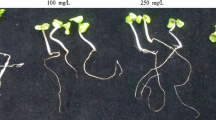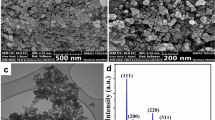Abstract
In this research, several biochemical variations in plant of Lemna minor L. were investigated to reflect Ag+ toxicity. Lemna minor L. changed colorless AgNO3 to colloidal brown at doses equal to and greater than 1 mg L−1. Optical and fluorescence microscopy revealed the presence of bright spots in roots of tested plant related to Ag/Ag2O-NPs. Photosynthetic pigment contents of Lemna minor L. declined upon exposure to Ag+ with an evidently higher decrease in chlorophyll a than in chlorophyll b. Similarly, Ag+ treatment caused an evident reduction in the activities of superoxide dismutase (SOD), peroxidase (POD), and catalase (CAT). The reduction in antioxidase activity was significantly higher in POD than in SOD and CAT. Ag+ treatment resulted in a significant increment in the level of malondialdehyde (MDA) content as the judging criteria of cellular injury which showed sign of dose-related. The alterations occurred in RAPD profiles of treated samples following Ag+ toxicity containing loss of normal bands, appearance of new bands, and variation in band intensities compared with the normal plants. In addition, morphological character and biomass of Lemna minor L. subjected to increasing Ag+ concentrations were evaluated to reveal Ag+ toxicity. Our study demonstrated that Lemna minor L. have a high sensitivity to indicate fluctuation of water quality. It would be beneficial that modulating the genotype of Lemna minor L. to bear high proportion of contaminates.






Similar content being viewed by others
References
Abei H (1984) Catalase in vitro. Methods Enzymol 105:121–126
Ali H, Khan E, Sajad MA (2013) Phytoremediation of heavy metals-concepts and applications. Chemosphere 91:869–881
Anjum NA, Gill SS, Duarte AC, Pereira E, Ahmad I (2013) Silver nanoparticles in soil-plant systems. J Nanopart Res 15:1896
Arenas LD, Carvalho LC, Santos ES, Abreu MM (2016) The physiological mechanisms underlying the ability of Cistus monspeliensis L. from São Domingos mine to withstand high Zn concentrations in soils. Ecotoxicol Environ Saf 129:219–227
Bagherzadeh HM, Ehsanpour AA (2016) Silver nanoparticles and silver ions: oxidative stress responses and toxicity in potato (Solanum tuberosum L.) grown in vitro. Hortic Environ Biotechnol 57:544–553
Beattie IR, Haverkamp RG (2011) Silver and gold nanoparticles in plants: sites for the reduction to metal. Metallomics 3:628–632
Beauchamp C, Fridovich I (1971) Superoxide dismutase: improved assays and an assay applicable to acrylamide gels. Anal Biochem 44:276–287
Chen G, Peijnenburg WJGM, Xiao Y, Vijver MG (2018) Developing species sensitivity distributions for metallic nanomaterials considering the characteristics of nanomaterials, experimental conditions, and different types of endpoints. Food Chem Toxicol 112:563–570
Dahiya UR, Ganguli M (2019) Exocytosis-a putative road-block in nanoparticle and nanocomplex mediated gene delivery. J Control Release 303:67–76
Drost W, Matzke M, Backhaus T (2007) Heavy metal toxicity to Lemna minor: studies on the time dependence of growth inhibition and the recovery after exposure. Chemosphere 67:36–43
Fatima RA, Ahmad M (2005) Certain antioxidant enzymes of Allium cepa as biomarkers for the detection of toxic heavy metals in wastewater. Sci Total Environ 346:256–273
Fayez KA, El-DBA, Mostafa NY (2017) Toxicity of biosynthetic silver nanoparticles on the growth, cell ultrastructure and physiological activities of barley plant. Acta Physiol Plant 39:155
Fourati R, Scopa A, Ahmed CB, Abdallah FB, Sofo A (2017) Leaf biochemical responses and fruit oil quality parameters in olive plants subjected to airborne metal pollution. Chemosphere 168:514–522
Foyer CH, Noctor G (2011) Ascorbate and glutathione: the heart of the redox hub. Plant Physiol 155:2–18
Gill SS, Tuteja N (2010) Reactive oxygen species and antioxidant machinery in abiotic stress tolerance in crop plants. Plant Physiol Biochem 48:909–930
Hafsi C, Romero-Puertas MC, del Río LA, Abdelly C, Sandalio LM (2011) Antioxidative response of Hordeum maritimum L. to potassium deficiency. Acta Physiol Plant 33:193–202
Harbison P (1986) Mangrove muds—a sink and a source for trace metals. Mar Pollut Bull 17:246–250
Hillman WS, Culley DD (1978) The uses of duckweed: the rapid growth, nutritional value, and high biomass productivity of these floating plants suggest their use in water treatment, as feed crops, and in energy-efficient farming. Am Sci 66:442–451
Hoeck AV, Horemans N, Monsieurs P, Cao HX, Vandenhove H, Blust R (2015) The first draft genome of the aquatic model plant Lemna minor opens the route for future stress physiology research and biotechnological applications. Biotechnol Biofuels 8:188
Hou WH, Chen X, Song GL, Wang QH, Chang CC (2007) Effects of copper and cadmium on heavy metal polluted waterbody restoration by duckweed (Lemna minor). Plant Physiol Biochem 45:62–69
Jiang HS, Li M, Chang FY, Li W, Yin LY (2012) Physiological analysis of silver nanoparticles and AgNO3 toxicity to Spirodela polyrhiza. Environ Toxicol Chem 31:1880–1886
Jiang HS, Qiu XN, Li GB, Li W, Yin LY (2014) Silver nanoparticles induced accumulation of reactive oxygen species and alteration of antioxidant systems in the aquatic plant Spirodela Polyrhiza. Environ Toxicol Chem 33:1398–1405
Jung WK, Koo HC, Kim KW, Shin S, Kim SH, Park YH (2008) Antibacterial activity and mechanism of action of the silver ion in Staphylococcus aureus and Escherichia coli. Appl Environ Microbiol 74:2171–2178
Kaushik D, Aryadeep R (2014) Reactive oxygen species (ROS) and response of antioxidants as ROS-scavengers during environmental stress in plants. Front Environ Sci 2:53
Khataee AR, Movafeghi A, Torbati S, Lisar SYS, Zarei M (2012) Phytoremediation potential of duckweed (Lemna minor L.) in degradation of CI Acid Blue 92: artificial neural network modeling. Ecotoxicol Environ Saf 80:291–298
Koizhaiganova M, Yas I, Gülümser G (2015) Assessment of antibacterial activity of lining leather treated with silver doped hydroxyapatite. Int Biodeterior Biodegrad 105:262–267
Koontz HV, Berle KL (1980) Silver uptake, distribution, and effect on calcium, phosphorus, and sulfur uptake. Plant Physiol 65:336–339
Leandro DNJ, Furtado AA, Barroso JP, Mangabeira PAO, Ahnert D, Sousa AGR et al (2018) Physiological, ultrastructural, biochemical and molecular responses of young cocoa plants to the toxicity of Cr (III) in soil. Ecotoxicol Environ Saf 159:272–283
Li SX, Feng YZ, Yang H, Jian CN (2011) Thorough removal of inorganic and organic mercury from aqueous solutions by adsorption on Lemna minor powder. J Hazard Mater 186:423–429
Liu W, Li PJ, Qi XM, Zhou QX, Zheng L, Sun TH, Yang YS (2005) DNA changes in barley (Hordeum vulgare) seedlings induced by cadmium pollution using RAPD analysis. Chemosphere 61:158–167
Ma C, Chhikara S, Xing B, Musante C, White JC, Dhankher OP (2013) Physiological and molecular response of Arabidopsis thaliana (L.) to nanoparticle cerium and indium oxide exposure. ACS Sustain Chem Eng 1:768–778
Macmullen J, Zhang Z, Dhakal HN, Radulovic J, Karabela A, Tozzi G (2014) Silver nanoparticulate enhanced aqueous silane/siloxane exterior facade emulsions and their efficacy against algae and cyanobacteria biofouling. Int Biodeterior Biodegrad 93:54–62
Malekia M, Ghorbanpourb M, Karimanc K (2017) Physiological and antioxidative responses of medicinal plants exposed to heavy metals stress. Plant Gene 11:247–254
Mallick N (2004) Copper-induced oxidative stress in the chlorophycean microalga Chlorella vulgaris: response of the antioxidant system. J Plant Physiol 161:591–597
Michael PI, Krishnaswamy M (2011) The effect of zinc stress combined with high irradiance stress on membrane damage and antioxidative response in bean seedlings. Environ Exp Bot 74:171–177
Nowack B, Bucheli TD (2007) Occurrence, behavior and effects of nanoparticles in the environment. Environ Pollut 150:5–22
Peddisetty PS, Gupta Y, Tanuj P, Peddisetty S, Shilpi N, Jyoti S et al (2014a) Reducing strength prevailing at root surface of plants promotes reduction of Ag+ and generation of Ag0/Ag2O nanoparticles exogenously in aqueous phase. PLoS One 9:e106715
Peddisetty PS, Yamal G, Peddisetty T, Sharmila P, Singh J, Nagarajan R et al (2014b) Plants fabricate Fe-nanocomplexes at root surface to counter and phytostabilize excess ionic Fe. BioMetals 27:97–114
Peddisetty PS, Yamal G, Peddisetty T, Sharmila P, Rao KS (2014c) Root system of live plants is a powerful resource for the green synthesis of Au-nanoparticles. RSC Adv 4:7361–7367
Petra PŠCP, Biba R, Domijan AM, Balen B (2018) Physiological, ultrastructural and proteomic responses of tobacco seedlings exposed to silver nanoparticles and silver nitrate. Chemosphere 209:640–653
Polle A, Seifert OF (1994) Apoplastic peroxidases and lignification in needles of Norway spruce (Picea Abies L.). Plant Physiol 106:53–60
Popova E (2017) Impact of heavy metals on photosynthetic pigment content in roadside plant communities. AIP Conference Proceedings 1899:050003
Rai, Kumar P (2009) Heavy metal phytoremediation from aquatic ecosystems with special reference to macrophytes. Crit Rev Environ Sci Technol 39:697–753
Ratte HT (1999) Bioaccumulation and toxicity of silver compounds: a review. Environ Toxicol Chem 18:89–108
Sartory DP, Grobbelaar JU (1984) Extraction of chlorophyll a from freshwater phytoplankton for spectrophotometric analysis. Hydrobiologia 114:177–187
Satoko I, Atsuko M, Seishiro A, Motomi I, Yasuro K, Keiko K (2009) Molecular adaptation of rbcL in the heterophyllous aquatic plant Potamogeton. PLoS One 4:e4633
Scoccianti V, Bucchini AE, Iacobucci M, Ruiz KB, Biondi S (2016) Oxidative stress and antioxidant responses to increasing concentrations of trivalent chromium in the Andean crop species Chenopodium quinoa Willd. Ecotoxicol Environ Saf 133:25–35
Shabnam N, Sharmila P, Govindjee HK, Pardha SP (2017) Differential response of floating and submerged leaves of longleaf pondweed to silver ions. Front Plant Sci 8:1052
Shahid M, Dumat C, Khalid S, Schreck E, Xiong T, Niazi NK (2016) Foliar heavy metal uptake, toxicity and detoxification in plants: a comparison of foliar and root metal uptake. J Hazard Mater S0304389416310937
Sharma P, Jha AB, Dubey RS, Pessarakli M (2012) Reactive oxygen species, oxidative damage, and antioxidative defense mechanism in plants under stressful conditions. J Botany 2012:217037
Shi T, Chen Y, Liu Y, Wu G (2014) Visible and near-infrared reflectance spectroscopy-an alternative for monitoring soil contamination by heavy metals. J Hazard Mater 265:166–176
Song U, Jun H, Waldman B, Roh J, Lee EJ (2013) Functional analyses of nanoparticle toxicity: a comparative study of the effects of TiO2 and Ag on tomatoes (Lycopersicon Esculentum). Ecotoxicol Environ Saf 93:60–67
Su C, Jiang LQ, Zhang WJ (2014) A review on heavy metal contamination in the soil worldwide: situation, impact and remediation techniques. Environ Skept Critics 3:24–38
Talebpour Z, Haghighi F, Taheri M, Hosseinzadeh M, Gharavi S, Habibi F, Aliahmadi A, Sadr AS, Azad J (2019) Binding interaction of spherical silver nanoparticles and calf thymus DNA: comprehensive multispectroscopic, molecular docking, and RAPD PCR studies. J Mol Liq 289:111185
Tarrahi R, Khataee A, Movafeghi A, Rezanejad F, Gohari G (2017) Toxicological implications of selenium nanoparticles with different coatings along with Se4+ on Lemna minor. Chemosphere 181:655–665
Topp C, Henke R, Keresztes Á, Fischer W, Eberius M, Appenroth KJ (2011) A novel mechanism of abscission in fronds of Lemna minor L. and the effect of silver ions. Plant Biol 13:517–523
Tripathi A, Liu S, Singh PK, Kumar N, Pandey AC, Tripathi DK, Chauhan DK, Sahi S (2017) Differential phytotoxic responses of silver nitrate (AgNO3) and silver nanoparticle (AgNPs) in Cucumis sativus L. Plant Gene 11:255–264
Varga M, Janja H, Barišić L, Lončarić Z, Sikirić MD, Erceg I et al (2018) Physiological and biochemical effect of silver on the aquatic plant Lemna gibba L.: evaluation of commercially available product containing colloidal silver. Aquat Toxicol 207:52–62
Verma S, Dubey RS (2003) Lead toxicity induces lipid peroxidation and alters the activities of antioxidant enzymes in growing rice plants. Plant Sci 164:645–655
Wang Y, Fang J, Leonard SS, Rao KMK (2004) Cadmium inhibits the electron transfer chain and induces reactive oxygen species. Free Radic Biol Med 36:1434–1443
Wuana RA, Okieimen FE (2011) Heavy metals in contaminated soils: a review of sources, chemistry, risks and best available strategies for remediation. ISRN Ecol 2011:1–20
Xing W, Huang WM, Liu GH (2010) Effect of excess iron and copper on physiology of aquatic plant Spirodela polyrrhiza (L.) Schleid. Environ Toxicol 25:103–112
Zahed H, Ghazala M, Setsuko K (2015) Plant responses to nanoparticle stress. Int J Mol Sci 16:26644–26653
Zahid RA, Alobaidi BK, Abd BA (2011) Molecular investigation of genetic polymorphisms in type 2 diabetic patients using random amplified polymorphic DNA (RAPD-PCR). Iraqi J Cancer Med Genet 4:2
Zhang J, Yang N, Geng Y, Zhou J, Lei J (2019) Effects of the combined pollution of cadmium, lead and zinc on the phytoextraction efficiency of ryegrass (Lolium perenne L.). RSC Adv 9:20603–20611
Zheng S, Zhang XY, Zhang LJ et al (2019) Effects of hydroponic cultivation on growth and photosynthesis of blueberry seedlings. Fujian J Agric Sci 34:306–312
Funding
This work was supported by the Fundamental Research Funds for the Central Universities (grant numbers N2001016 and N2001012) and the Key Technologies Research and Development Program (grant number 2019YFC1803804).
Author information
Authors and Affiliations
Corresponding author
Additional information
Responsible Editor: Philippe Garrigues
Publisher’s note
Springer Nature remains neutral with regard to jurisdictional claims in published maps and institutional affiliations.
Haibo Li and Fan Mo are co-first authors of the article and contribute equally to this research.
Electronic supplementary material
ESM 1
(XLSX 382 kb)
Rights and permissions
About this article
Cite this article
Li, H., Mo, F., Li, Y. et al. Effects of silver(I) toxicity on microstructure, biochemical activities, and genic material of Lemna minor L. with special reference to application of bioindicator. Environ Sci Pollut Res 27, 22735–22748 (2020). https://doi.org/10.1007/s11356-020-08844-8
Received:
Accepted:
Published:
Issue Date:
DOI: https://doi.org/10.1007/s11356-020-08844-8




